|
"Canaanean Blades
and the associated Tabular Scrapers are a very characteristic Early
Bronze Age artifact and were widely traded throughout the Middle East.
The blades are noted for their size, regularity, and high degree of
technical skill indicated."--------1992,
Eugene M. Futato, "Personal communication."
"Canaanean blades and sickle segments are a widespread
and characteristic artifact of the Early Bronze Age in the southern
Levant."--------1996,
Eugene M. Futato, "Early Bronze III Canaanean Blade/Scraper Cores
From Tell Halif, Israel," Retrieving The Past, Essays On
Archaeological Research And Methodology In Honor Of Gus W. Van Beek,
p. 61.
"Levant----The
regions on the eastern Mediterranean and the Aegean, from Greece to
Egypt------."------1979,
Noah Webster, "Webster's Deluxe Unabridged Dictionary,"
p. 1040.
"The most
unusual aspect of the Canaanean blade technology at Tell Halif (in
Israel) is there is no evidence for
preliminary flaking of the faces of the blade cores. These faces do not
appear to have been prepared."--------1996,
Eugene M. Futato, "Early Bronze III Canaanean Blade/Scraper Cores
From Tell Halif, Israel," Retrieving The Past, Essays On
Archaeological Research And Methodology In Honor Of Gus W. Van Beek,
p. 66.
"We
presume that actual blade preparation was done by indirect percussion,
using a punch. Controlling the precise point of application and
direction of force is critical in removing long, thin blades from a core."----1996,
Eugene M. Futato, "Early Bronze III Canaanean Blade/Scraper Cores
From Tell Halif, Israel," Retrieving The Past, Essays On
Archaeological Research And Methodology In Honor Of Gus W. Van Beek,
p. 67.
"Four basic technologies were used for the
manufacture of sickles (blades)
in the post-Neolithic periods"---------1997,
Steven A. Rosen, "Lithics After The Stone Age," p. 44.
"Backing on
Canaanean sickles is virtually absent. Some rare pieces seem to show a
kind of burin-blow backing but it is difficult to know if this is
intentional or the result of longitudinal breakage."---------1997,
Steven A. Rosen, "Lithics After The Stone Age," p. 48.
"Shortly
after 13,000 B.C. (in Egypt)
grinding stones and sickle blades with glossy sheen on their bits appear
in Late Paleolithic tool kits"---------1979,
Michael A. Hoffman, "Egypt Before The Pharaohs, The Prehistoric
Foundations Of Egyptian Civilization," p. 88.
"Grain and
other field crops (in Cyprus)
were harvested with sickles, a labor intensive practice. According to
Mr. Georghiou, since harvesting often was too much work for any one
family, additional workers were usually hired."--------2000,
John C. Whittaker, "The Ethnoarchaeology Of Threshing In Cyprus,"
Near Eastern Archaeology, 63:2, p. 63.

CANAANEAN SICKLE BLADES
EARLY BRONZE AGE
TELL HALIF, ISRAEL
2500 TO 2300 B.C.
Early descriptions of Canaanean blades refer to
them as "ribbon knives." The name is a reflection of their long,
straight and uniform lines. Canaanean blades are described as one of the
most important and elaborate lithic technologies of the Middle East.
They first appear in the southern Levant region of the
eastern Mediterranean during the Early Bronze Age. |
|
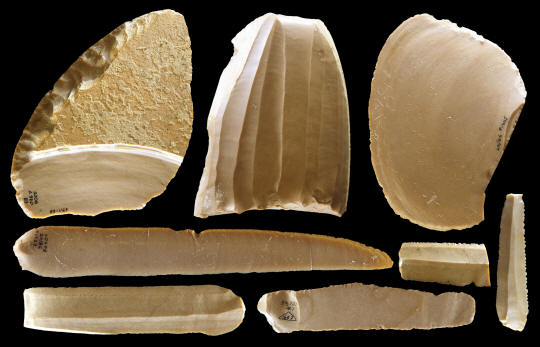
CLICK ON PICTURE FOR LARGER IMAGE
CANAANEAN SICKLE BLADES, UNUSED
BLADES, CORE,
TABULAR SCRAPER & BLANK
EARLY BRONZE III PERIOD SITE
TELL HALIF, ISRAEL
2500 TO 2300 B.C.
This picture shows several examples
of Canaanean core and blade/flake production related artifacts. They were
excavated on an Early Bronze Age site in southern Israel at Tell
Halif in the southern Levant region. At top center is a core with several uniform long narrow
blade removal scars. At top left and right are two good examples of
tabular scrapers. The example on the right is described as a blank
(unused). At center left and lower left are two unused Canaanean
blades. At second row second from left is a sickle blade segment
that has sickle sheen from use. At lower right is a blade that is
described as a reaper knife and it also has sickle sheen from use.
At bottom row center is a blade that was used as a scraper and may
have been resharpened from a much larger tabular scraper. The longest blade in
this picture measures 8 3/4 inches (22.2 cm) long. |
|
|
Canaanean blades were first described and named by R.
Neuville in 1930. He coined the term Canaanean and referred to them as
"des couteaux a aretes," which translates to "edges of knives." |
|
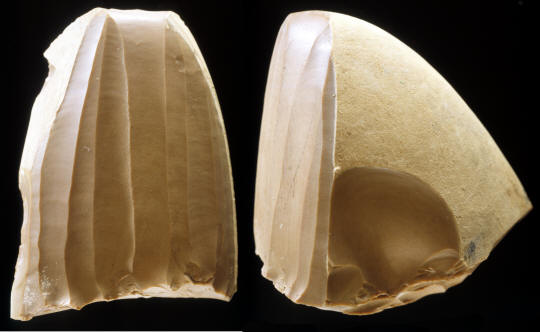
CLICK ON PICTURE FOR LARGER IMAGE
COMBINATION CANAANEAN BLADE &
TABULAR SCRAPER CORE
EARLY BRONZE III PERIOD SITE
TELL HALIF, ISRAEL
2500 TO 2300 B.C.
This core, and other cores
from Tell Halif are most notable for their duel purpose blade/flake tool
production. They produced long narrow blades from one side of the core
and large oval tabular flakes from another side. The picture on the left
shows an area of the core where long narrow blades were uniformly
removed for the production of sickle blades and reaping knives. The
picture on the right shows an area of the core where a large oval
cortical (outer surface)
flake was removed for use as either a scraper or knife. Canaanean cores
are described as large single platform blocks that were worked on one to
three faces. Blades from Tell Halif are described as having been removed indirectly with a
punch. But Chabot and Pelegrin's analysis of hundreds of Canaanean blades
from the Tell Atij and Tell Gudeda sites in Syria, showed a high
percentage of those blades were removed by lever-pressure with the use
of a copper point. Platforms are narrow relative to the blade and often show
faceting. Unlike other post Neolithic sickle blade technologies in the
Levant region, Canaanean blade technology is known for the production of
long blades. These types of blades can be greater than 5 7/8 inches (15
cm) long and could produce multiple sickle blade segments per blade. |
|
|
The Canaanean artifacts illustrated in this report were found
during excavation on the Tell Halif site. Tell Halif is located in southern Israel along the
southwestern edge of the Judean Hills. Excavation of the site was
sponsored by The Cobb Institution Of Archaeology at Mississippi State
University. The project began in 1983 and is called the Lahav Research
Project. Eugene Futato spent four summers on the site and did the lithic
analysis. |
|

CLICK ON PICTURE FOR LARGER IMAGE
UN-USED CANAANEAN BLADE
EARLY BRONZE III PERIOD SITE
TELL HALIF, ISRAEL
2500 TO 2300 B.C.
This is the longest
blade that was found during the Tell Halif excavation. It's actually
longer than most Canaanean blades. It's impressive for its size and also
for how flat and straight it is. Futato describes the blades from Tell
Halif as being
produced with indirect percussion, with a hammer sticking a punch. This
blade was never used. It measures 1/4 inch (6 mm) thick at the
bulb-of-percussion and 1/8 inch (3 mm) thick at the center of the blade. It also measures 1 3/16 inches (3 cm)
wide and 8 3/4 inches (22.2 cm) long. |
|
|
The Canaanean core and blade artifacts that were found
on the Tell Halif site date to the Early Bronze Age between 2500 and 2300 B.C.
The Tell Halif site also produced artifacts from the Chalcolithic era as
early as 5,500 years ago. Other periods were represented by the Late
Bronze Age, Iron Age and as recent as the Persian and Hellenistic Period
2,100 years ago. |
|
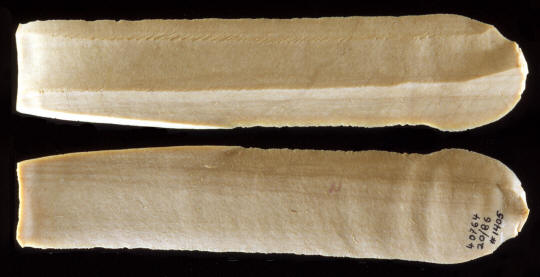
CLICK ON PICTURE FOR LARGER IMAGE
UN-USED CANAANEAN BLADE
EARLY BRONZE III PERIOD SITE
TELL HALIF, ISRAEL
2500 TO 2300 B.C.
This unused blade was found
on the surface of a house floor in a cache along with eight other blades
and one tabular scraper. It has a "classic" Canaanean style trapezoidal cross section
that was formed by the removal of three previous blades. This blade also
has a flat profile except for a slight curve near the distal end and
fairly uniform parallel edges. The bulb-of-percussion is very thin and
is only slightly over 1/32 of an inch thicker than the rest of the
blade. This blade measures 5 3/16 inches (13.2 cm) long. |
|
|
Artifacts found during the excavation of the Tell Halif site
produced enough evidence to show that the location was a sickle blade
and tabular scraper manufacturing site. The artifacts include nine Canaanean
type cores, core fragments and other core manufacturing debris. Plus
un-utilized Canaanean blades and blades that had been modified and used
as tools. |
|
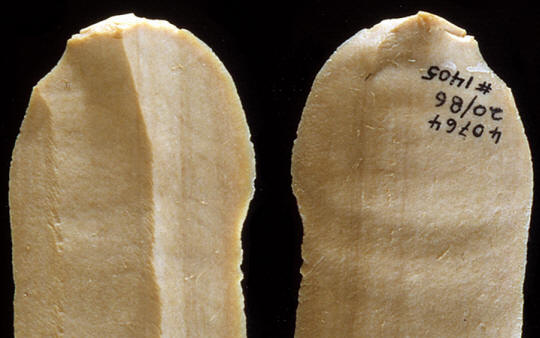
CLICK ON PICTURE FOR LARGER IMAGE
CANAANEAN SICKLE BLADE STRIKING
PLATFORM & BULB-OF-PERCUSSION
EARLY BRONZE III PERIOD SITE
TELL HALIF, ISRAEL
2500 TO 2300 B.C.
This picture shows a
close-up view of the proximal end of the previously described blade. The
striking platform is still intact. Several of the nine blades that were
found together in a cache with this blade are reported to have retained
their striking platforms. Prepared striking platforms were placed over
the raised edges of previously removed blades. The thickest part of a
blade is located where the blade was struck from the core at the bulb of
percussion. This blade is very thin at the bulb of percussion and
measures only slightly thicker than the rest of the blade. The
percussion bulb measures 7/32 inch thick and the thickest area of the
blade measures 6/32 of an inch thick. |
|
|
Canaanean cores and blades were made from high quality
flint or chert. The material is identified by Rosen (1997) as a fine
grained Eocene flint. He reports that the majority of Canaanean blades
that have been found in the southern Levant are made of this material.
The colors range from chocolate, brown, to sometimes banded flint. |
|
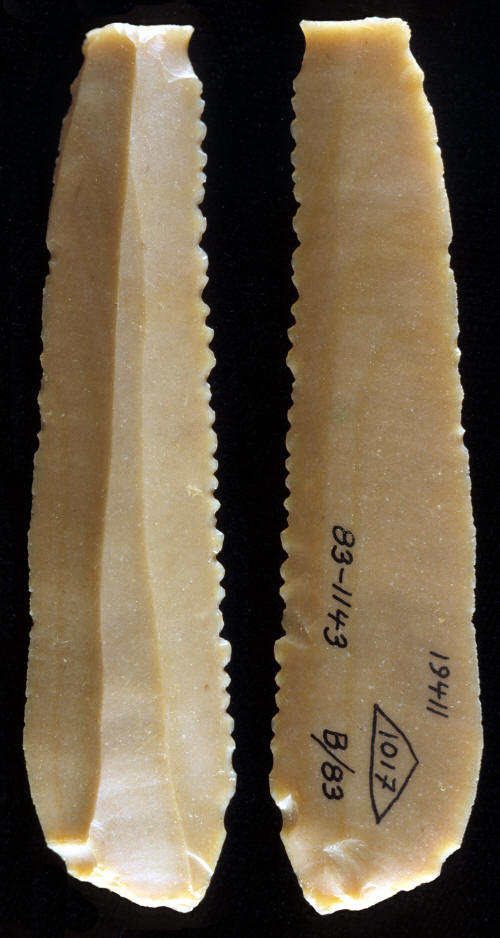
CLICK ON PICTURE FOR LARGER IMAGE
CANAANEAN BLADE REAPING KNIFE
EARLY BRONZE III PERIOD SITE
TELL HALIF, ISRAEL
2500 TO 2300 B.C.
This Canaanean
blade from Tell Halif is described as a reaping knife, as opposed to a
sickle blade segment. Sickle blade segments were made by snapping short
segments from longer blades. Reaping knives are intact blades and were
used without modification. It's believed that sickle blade segments were
hafted onto a curved crescent shaped handle and reaping knives were
hafted in a straight line. This reaping knife has a glossy silica
coating on its serrated cutting edge indicating it was probably used to
harvest some type of plant materials. |
|
|
Some of the
cores from Tell Halif are most notable for their duel purpose. Long
narrow blades were removed from one side of a core
and large oval tabular flakes from another side. Canaanean cores are
described as large single platform blocks that were worked on one to
three faces. |
|

CLICK ON PICTURE FOR LARGER IMAGE
SERRATED EDGE OF A CANAANEAN
REAPING KNIFE
EARLY BRONZE III PERIOD SITE
TELL HALIF, ISRAEL
2500 TO 2300 B.C.
This picture shows a close up view of a portion of the cutting edge
of the previously described reaping knife. The edge has a sickle
sheen silica polish from cutting plants. |
|
|
Futato describes the Tell Halif Canaanean blades as having
been produced by indirect percussion with the use of a punch. But,
Chabot and Pelegrin's analysis of hundreds of Canaanean blades
from the Tell Atij and Tell Gudeda sites in Syria, showed a high
percentage of those blades were removed by lever-pressure with the use
of a copper point. But they also note that a substantial fraction of
them were also detached by indirect percussion (punch flaking). Their
research showed that Canaanean flint-smiths used both techniques for
blade removals. |
|
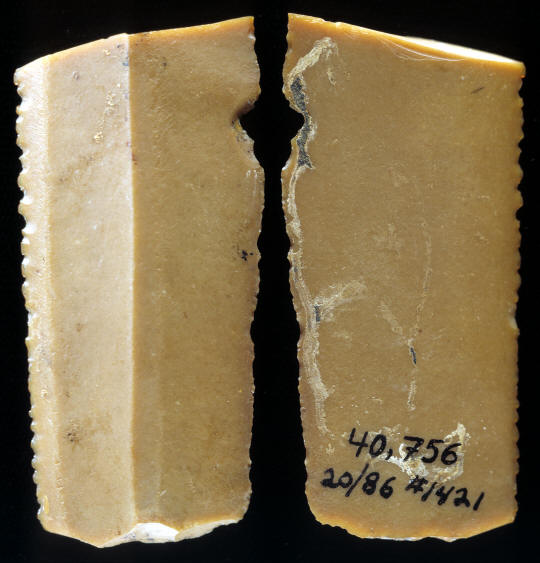
CLICK ON PICTURE FOR LARGER IMAGE
CANAANEAN SICKLE BLADE SEGMENT
EARLY BRONZE III PERIOD SITE
TELL HALIF, ISRAEL
2500 TO 2300 B.C.
This sickle blade segment
is identified as a product of Canaanean prismatic blade technology.
Sickle sheen along one serrated edge indicates that it was once used to
cut some type of plant fibers. Sickle blades were sometimes used to cut
on both edges. On a site in the Jordan Valley in Israel called Wadi
Fazael 2, it's reported that 32.6% of 43 sickle blades were reversed in
the haft and have bilateral sheen on their cutting edges. This blade
also appears to have traces of some type of material along one edge that
may be a hafting residue, such as bitumen. Bitumen is a solid or
semi-solid form of petroleum that is known to have been used to secure
sickle blades onto sickle handles. Most Canaanean blades have two
parallel ridges that extend down the length of the blade. The ridges are
formed along the edges of previously detached blades. This sickle blade
has a third dorsal ridge indicating a fourth blade was detached from the
core prior to the removal of this blade. Rosen writes that un-used
Canaanean blades average about 3/4 of an inch or 2 cm wide and they can
sometimes be greater than 5 7/8 inches (15 cm) long. This sickle blade
was made from a non-local fine grained brown flint. It measures 2 5/16
inches (5.9 cm) long and 1 1/16 inches (2.7 cm) wide. |
|
|
The economical use of some Canaanean sickle blades
is demonstrated by evidence of edge wear and sickle sheen on both
cutting edges. Rosen notes that up to 40% of the Canaanean blade
segments he observed were reversed in the haft. |
|
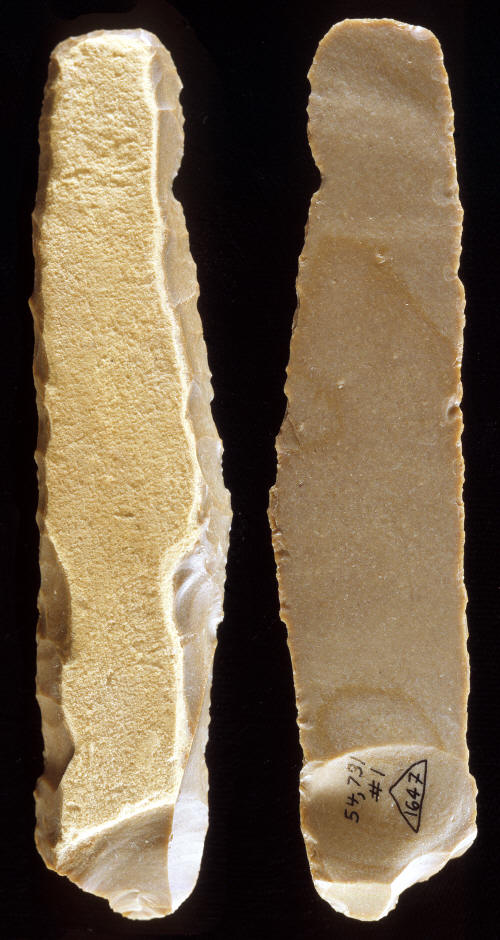
CLICK ON PICTURE FOR LARGER IMAGE
CANAANEAN SCRAPER
EARLY BRONZE III PERIOD SITE
TELL HALIF, ISRAEL
2500 TO 2300 B.C.
This Canaanean scraper was sharpened into its current form from a
larger cortical (outer
core surface) flake. The original
outer cortex surface covers one side. This side and end-scraper is steeply
trimmed on three sides. Its most interesting characteristic is the
removal of the bulb of percussion. A single percussion flake cleanly
removed what was once the thickest area of the flake. This sickle
blade was made from a non-local chocolate colored fine grained
flint. It measures 5 1/8 inches (13 cm) long. |
|
|
Canaanean blades are generally long.
In fact, they are the longest that were produced by the four different
sickle blade manufacturing technologies that were in use at that time.
Canaanean blades are considered the
most efficient for the production of sickle blade segments because their
greater length could produce as many as three segments from one blade (Rosen: 1997). |
|
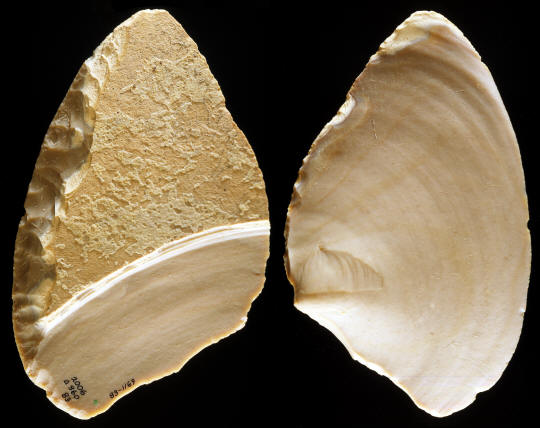
CLICK ON PICTURE FOR LARGER IMAGE
TABULAR SCRAPER
EARLY BRONZE III PERIOD SITE
TELL HALIF, ISRAEL
2500 TO 2300 B.C.
Tabular scrapers are
described as one of the lithic industries of the Early Bronze Age in the
Levant region. They are referred to as either tabular or fan scrapers
and they could be used as either scrapers or knives. Tabular scrapers were
made from large flat cortical (outer core surface)
flakes that were struck from flint nodules. Rosen describes them as
having outer cortex on virtually all of their dorsal surfaces. He also
explains that edge wear analysis has identified many of them as
butchering knives rather than scrapers. They may also have been used for
ritual purposes because some examples have incised designs on the cortex
and are found near temples and shrines. The suggestion is that they were
sometimes used in ritual sacrifice ceremonies.
Tabular scrapers can vary in size and
shape from fan, oval, round, elongate and irregular shapes. They range
in size from an average of 7 7/8 inches by 5 7/8 inches (20 cm by 15 cm)
up to 23 5/8 inches (60 cm). This example was made from a cortical flake
that was struck from a nodule of high quality fine grained flint. It
measures 5 3/4 inches (14.6 cm) long and 3 7/16 inches (8.8 cm) wide. |
|
|
There were four
different sickle blade production technologies in use in the Levant
region just after the end of the Neolithic period. Canaanean core
technology produced the highest quality blades. Another core and blade
technology is referred to as "non-Canaanean prismatic blades." This
technology produced small blades from cores that average between 2 3/8
inches (6 cm) to 3 1/8 inches (8 cm) long. These types of blades also
have a prism-like pattern on their dorsal surface. Another sickle blade
technology is described as "simple blade" and the fourth is termed
"flake-blade." |
|
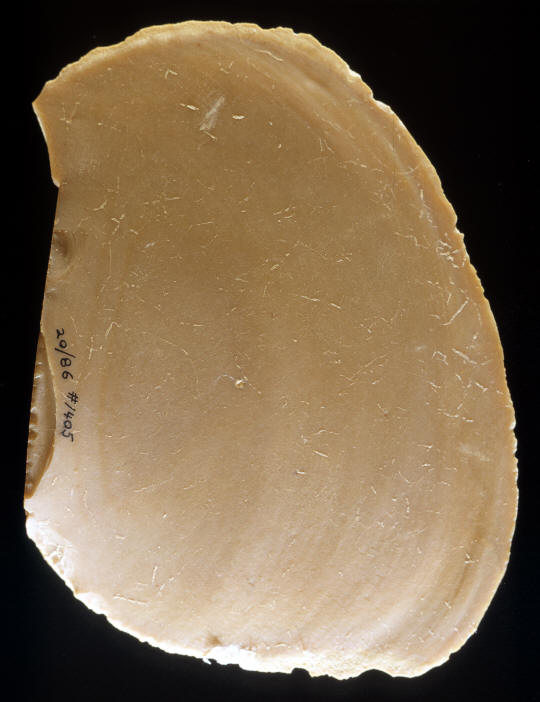
CLICK ON PICTURE FOR LARGER IMAGE
TABULAR SCRAPER BLANK
EARLY BRONZE III PERIOD SITE
TELL HALIF, ISRAEL
2500 TO 2300 B.C.
This picture shows one side
of a thin tabular scraper flake that was found in a cache along with at
least nine Canaanean blades. The opposite surface of this cortical flake
is the outer cortex of the nodule core. This flake doesn't show any
heavy use wear along its edges and it's been described as a scraper
blank. But it does have some pressure
"nibbling" on a portion of its edge. This minor trimming might suggest a
use as a knife. This flake measures 5 9/16 inches (14.1 cm) long and 3
7/8 inches (9.8 cm) wide. |
|
|
Canaanean blade
technology was a successful manufacturing process that lasted in the
north and in the south Levant region for hundreds of years (Rosen: 1997,
59). The technology was used by craftsmen who traded their blades into
areas where quality lithic sources were not locally available. The demand
for quality products has always been a natural human trait that still
increases with each passing year. |
|
"REFERENCES"
1930, Neuville, "Notes de Prehistoire
Palestinienne," Journal of the Palestine Oriental Society 10.
1979, Hoffman, Michael A., "Egypt Before The Pharaohs, The
Prehistoric Foundations Of Egyptian Civilization," p. 88.
1996, Futato, Eugene M., "Early Bronze III Canaanean Blade/Scraper
Cores From Tell Halif, Israel," Retrieving The Past, Essays On
Archaeological Research And Methodology In Honor Of Gus W. Van Beek,
p. 61.
1997, Rosen, Steven A., "Lithics After The Stone Age," p. 44.
2000, John C. Whittaker, "The Ethnoarchaeology Of Threshing In
Cyprus,"
Near Eastern Archaeology, 63:2, p. 63.
2002, Lyons, Claire L., Papadopoulos, John K., "The Archaeology Of
Colonialism," p. 52.
2010, Bar, Shay & Winter, Haim,
"Canaanean Flint Blades In Chalcolithic Context And The Possible Onset
Of The Transition Of The Bronze Age: A Case Study From Fazael 2," Tel
Aviv, Vol. 37, pp. 33-34.
2012, Chabot, Jacques, & Pelegrin, Jacques, "Two Examples Of
Pressure Blade Production With A Lever: Recent Research From The
Southern Caucasus (Armenia) And Northern Mesopotamia (Syria and Iraq),"
The Emergence Of Pressure Blade Making; From Origin To Modern
Experimentation, pp. 181-198.
Personal Communication, Eugene M. Futato, 1992.
|
|
RECENT
LISTINGS HOME
ORDERING |